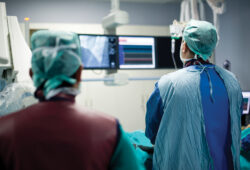Protecting Patients and Staff
For decades, injuries associated with patient handling were considered simply a hazard of the healthcare profession. But that mindset changed once organizations took a hard look at the consequences of patient handling injuries.
In addition to medical expenses, disability payouts and litigation costs, absenteeism and staff turnover represent huge costs to healthcare organizations. Data show incidences of musculoskeletal injuries in the healthcare industry are more than seven times the national average across all industries, with some nurses leaving patient care positions because of work-related risks, according to the Occupational Safety and Health Administration.
In total, direct and indirect expenses related to back injuries are estimated to cost the healthcare industry $20 billion each year. Safe patient handling (SPH) empowers organizations to put a dent in that number.
The Case for Better Education
Patient handling poses significant risks to healthcare workers. Lifting heavy loads—often while holding awkward positions—causes strains and sprains, the most common types of injuries.
It’s for these reasons that prominent associations like the National Institute for Occupational Safety and Health and the American Nursing Association subscribe to a minimal lift philosophy. However, this doesn’t change the fact that high-risk activities are everyday responsibilities for the average healthcare employee.
Transferring patients to and from a bed, chair, toilet or tub all place significant stress on the shoulders and lower back, a problem made worse by our nation’s obesity epidemic and growing numbers of elderly patients with limited mobility. Each facility and unit has its own unique risks, from emergency departments to diagnostic and rehab units.
In total, direct and indirect expenses related to back injuries are estimated to cost the healthcare industry $20 billion each year.
Smart healthcare organizations know SPH involves so much more than just lifts and slings. At its core, a truly effective SPH program relies on knowledgeable staff who are well trained in moving patients without subjecting themselves to undue injury risk. And while SPH education often begins in the career training phase, it’s up to company leadership to ensure SPH is a vital part of the organization’s culture as a whole.
Organizations that ignore this responsibility pay the price in terms of rising costs and increased liability. On the other hand, those that take charge experience reduced turnover and improved profitability.
A Smart Solution
Comprehensive safe patient handling programs give staff the tools they need to connect SPH concepts with the clinical setting, thereby reducing costs and inpatient injuries. But the solution is not simply one of technology.
In order for a program to achieve staff safety goals, facility administration must commit to making SPH education an integral part of employee training and culture. What does this type of commitment cost for organizations ready to take the plunge?
An SPH education program involves several costs. Hard costs include purchase of SPH equipment, plus training courses for coordinators and staff. SPH education also includes making time for a facility risk assessment and action plan. Soft costs of creating an SPH program include equipment system maintenance, continuing education for staff and coordinators, and staff hours set aside for periodic program review and evaluation to make sure goals are on track.
Putting together a plan may seem like a daunting task. Fortunately, Hill-Rom offers a program development workshop to help healthcare organizations streamline SPH program implementation to reduce injuries and associated costs.
Hill-Rom’s offerings include SPH training for coordinators as well as a Clinical Solutions Course for facility staff—both essential components for ensuring SPH is fully incorporated into your organization’s culture.
The coordinator training provides a framework for ensuring the success of an organization’s SPH program. Attendees learn how to recognize the barriers to an effective SPH program, as well as how to handle all aspects of program development using Hill-Rom’s Safe Transfers and Movement Program (STAMP).
The STAMP is based on Hill-Rom’s framework of seven essential elements of implementing an SPH program: administrative support, SPH team development, risk identification, clinical equipment solution, program development, education and quality improvement metrics.
The clinical solutions course focuses on SPH practices and equipment in various clinical settings—including rehab, acute care, and diagnostic and imaging units—where staff learn how to connect SPH principles, concepts and skills to national patient safety goals. The course covers how to safely move bariatric patients, plus SPH applications in neurology units for patients with stroke, spinal cord or traumatic brain injuries.
Visit hill-rom.com/STAMP for more information.
Share Email Education, Safe Patient Handling





